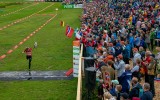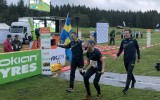The advantage with an orienteering race compared with any other race is that every competitor has a chance to win, a newspaper newspaper in 1927.
Maps and compasses for leisure use slowly began to be common in Norway in the latter half of the 19th century. The engineer Ernst Bjerknes published a map over Nordmarka – a forested area north of Kristiania (Oslo) – in 1890. The map, which had a scale of 1:30 000, was aimed at cross-country skiers and hikers and facilitated the opening up of the Norwegian capital’s surrounding wilderness to the public.
Early attempts
However, orienteering as a competitive sport began within the military. The term “orienteering race” was probably first used in Norway in 1895 during a military exercise at Gardermoen.
After some time, the new phenomenon reached Østfold – or Smaalenene county as it was called then. A local newspaper reported on Tuesday 9 August 1898 from a military sports event outside Halden (then called Fredrikshald):
The sergeant class’ task was to find their way from Gimleløkken farm to Asak church. Each man was allowed to study the map for a short time before he started his run. He did not carry the map with him.
The recruits completed their tasks with distinction, according to the newspaper’s correspondent. As the crow flies, the course measured around five kilometres. The two best results were Sergeant-recruit Lien with 43 minutes, 30 seconds, followed by Sergeant-recruit Strand with 47:22.
The world’s first
What is commonly acknowledged as the world’s first civilian cross-country orienteering competition took place from Grøttum in Sørkedalen outside Kristiania on 31 October 1897. The event was organised by IK Tjalve. This time the race ventured into unfamiliar terrain. Map and compass was “allowed” stated the invitation but the athletes probably had to bring their own maps. The course was 10.5 kilometres long with three controls. Peder Fossum from Glimt won the race with the time 1.41:07.
One of the first events in Østfold was held in 1905, organised by Baastad IF and with 11 participants.
A new start
After a number of years in hiatus, orienteering woke up again in Norway in 1925 with a race in Hurum. The tobacco dealer and journalist Trygve Gulbranssen and three others had been to Stockholm where they observed how the Swedes did it. Gulbranssen wrote a long piece about the race in the journal Idrætsliv.

PHOTO: The author Trygve Gulbranssen, who lived in Eidsberg for many years, was a pioneer for the spreading of orienteering as a sport in the 1920s. Photo: Wikimedia Commons.
Later he became famous as the author of The Bjørndal Trilogy (one of his books, Beyond Sing the Woods, has been published in English). The last two decades of his life he lived on Hobøl farm in Eidsberg, Østfold county.
«The big race»
In the mid-1920s orienteering again spread to Østfold. The county’s social democrat newspaper on 12 November 1927 published an article on its front page about Fredrikstad ski club’s initiative to organise an orienteering event for the district, referred to as the first orienteering race ever to be organised in Østfold.

PHOTO: Story on the front page of Smaalenenes Social-Demokrat 12. november 1927.
Mr. I. B. Tendal from the ski club’s press committee had signed the piece. He explained the rules and then wrote that every interested sportsman presumably is already aware of what an excellent form of sport orienteering is.
The event was scheduled to take place on Sunday 20 November and the organisers had to lure at least 25 competitors into the woods. According to the race’s propaganda people, no one should stay away for want of winning chances:
The advantage with an orienteering race compared with any other race is that every competitor has a chance to win … the best athlete may well run till he dives into the ground and still be beaten by a competitor who slowly walks the entire course.
Too expensive?
The starting fee was NOK 3, however the organisers admitted that it might be a bit dear during these difficult times. On the other hand, the fee included food as well as transport to the secret location where the race was to be held. In addition, obtaining a pocket compass was recommended.
Perhaps did prospective participants find it too expensive or they did not feel convinced that everyone had a chance to win. At least, no report from the event seems to have been published in the paper afterwards.
But soon there were more opportunities to try orienteering in the woods of Østfold.
Debut in Halden
It is difficult to ascertain who was really first. In Halden a race was organised in 1925. On 4 December 1927, Halden sports club arranged for an event that started near Buer railway station in Idd. The course measured six kilometres and had three controls. Among 30 participants, the first prices went to Sergeant Myhrer in the class for athletes above the age of 30 whereas A. Hasle topped the “youth” class for those under 30.
Today Halden and Fredrikstad are Østfold’s strongest bastions for orienteering. The sport has a long tradition in both cities. In fact, orienteering has been practised in some form or the other in Østfold for more than 120 years.



